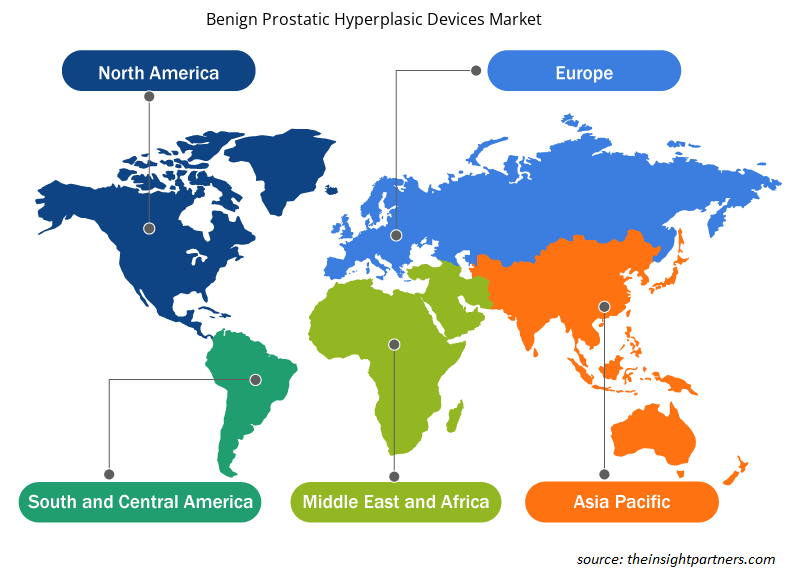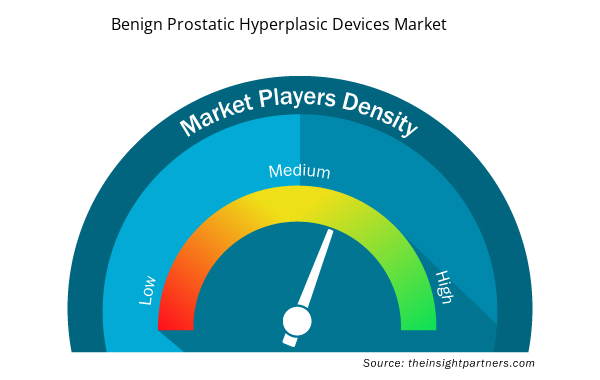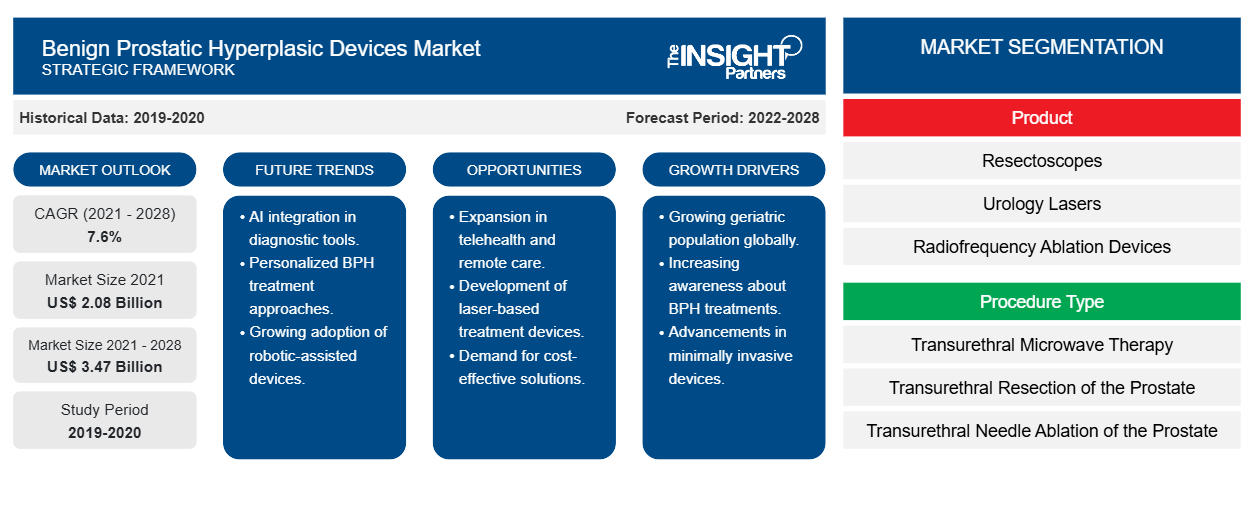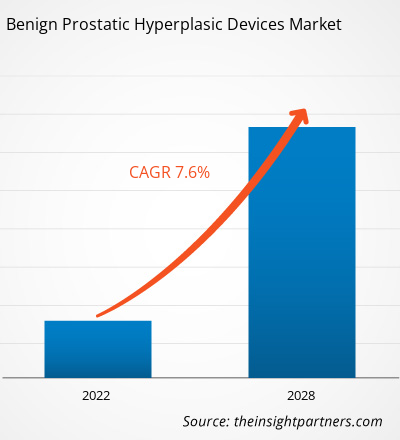[Rapporto di ricerca] Si prevede che il mercato dei dispositivi per l'iperplasia prostatica benigna crescerà da 2.078,78 milioni di dollari nel 2021 a 3.467,31 milioni di dollari entro il 2028; si stima che crescerà a un CAGR del 7,6% dal 2022 al 2028.
Iperplasia prostatica benigna (IPB) è un ingrossamento della prostata causato da una crescita cellulare eccessiva nella prostata. L'IPB è una condizione benigna (non cancerosa) della prostata. Le condizioni non cancerose di solito non sono fatali e non si diffondono (metastatizzano) ad altre parti del corpo. L'IPB non aumenta il rischio di cancro alla prostata; a meno che non manifesti sintomi, l'IPB non è considerata un problema di salute. Quasi tutti gli uomini avranno una crescita della prostata entro i 70 anni. Invecchiare, avere più grasso sulla pancia (noto anche come obesità addominale) e non fare abbastanza esercizio fisico aumentano il rischio di sviluppare l'IPB.
Il mercato dei dispositivi per iperplasia prostatica benigna è segmentato in prodotto, tipo di procedura, utente finale e area geografica. Per area geografica, il mercato è ampiamente segmentato in Nord America, Europa, Asia Pacifico, Medio Oriente e Africa e Sud e Centro America. Questo rapporto offre approfondimenti e analisi approfondite del mercato, sottolineando parametri quali tendenze di mercato, dinamiche di mercato e analisi competitiva dei principali attori del mercato a livello mondiale.
Personalizza questo report in base alle tue esigenze
Riceverai la personalizzazione gratuita di qualsiasi report, comprese parti di questo report, o analisi a livello nazionale, pacchetto dati Excel, oltre a usufruire di grandi offerte e sconti per start-up e università
- Scopri le principali tendenze di mercato in questo rapporto.Questo campione GRATUITO includerà analisi di dati che spaziano dalle tendenze di mercato alle stime e alle previsioni.
Approfondimenti di mercato
L'aumento della prevalenza dell'iperplasia prostatica benigna, unito all'aumento dei fattori di rischio e all'incremento degli investimenti, dei fondi e delle sovvenzioni per la ricerca sul trattamento dell'iperplasia prostatica benigna, guideranno il mercato dei dispositivi per l'iperplasia prostatica benigna.
Secondo il National Center for Biotechnology Information (NCBI), la BPH è uno dei disturbi più comuni negli uomini anziani e la causa principale dei sintomi del tratto urinario inferiore (LUTS). Dopo i 40 anni, la prevalenza della BPH aumenta, raggiungendo un picco del 60% all'età di 90 anni. Secondo gli studi autoptici, la prevalenza istologica della BPH è rispettivamente dell'8%, del 50% e dell'80% nella quarta, sesta e nona decade di vita di un uomo. È stato anche dimostrato che la vecchiaia è un fattore di rischio per l'insorgenza e la progressione della BPH clinica in studi osservazionali condotti in Europa, negli Stati Uniti e in Asia. Secondo le statistiche del Krimpen and Baltimore Longitudinal Study of Aging, la prostata cresce a un tasso del 2,0%-2,5% all'anno negli uomini anziani. L'ingrossamento continuo della prostata è un fattore di rischio per lo sviluppo di LUTS e le prostate più grandi sono associate a un ingrossamento prostatico benigno (BPE), che innesca il rischio di sviluppare BPH clinica e incontinenza urinaria.NCBI), BPH is one of the most common disorders in older men and the leading cause of lower LUTS). After the age of 40, the prevalence of BPH rises, reaching a peak of 60% by the age of 90. According to autopsy studies, the histological prevalence of BPH is 8%, 50%, and 80% in the fourth, sixth, and ninth decades of a man's life, respectively. Old age has also been shown to be a risk factor for the onset and progression of clinical BPH in observational studies conducted in Europe, the US, and Asia. According to statistics from the Krimpen and Baltimore Longitudinal Study of Aging, the prostate grows at a rate of 2.0% to 2.5% per year in older men. Continued prostate enlargement is a risk factor for developing LUTS, and larger prostates are associated with a benign prostatic enlargement (BPE), which triggers the risk of developing clinical BPH and urine incontinence.
Secondo i dati NCBI, si è scoperto che l'aumento dell'adiposità ha una correlazione positiva con il volume della prostata. In numerosi gruppi di studio, il peso corporeo, l'indice di massa corporea (BMI) e la circonferenza della vita hanno mostrato una correlazione positiva con il volume della prostata. Inoltre, i dati epidemiologici mostrano che l'obesità può aumentare la necessità di un intervento chirurgico per la BPH e di iniziare il trattamento per la BPH.NCBI data, increased adiposity is found to have a positive correlation with prostate volume. In numerous study groups, body weight, body mass index (BMI), and waist circumference have been seen to have a positive correlation with prostate volume. Additionally, epidemiological data shows obesity may raise the necessity of BPH surgery and initiating BPH treatment.
Secondo l'American Journal of Men's Health (AJMH), nel 2019, a livello globale, ci sono stati 11,26 milioni di nuovi casi e 1,86 milioni di anni vissuti con disabilità (YLD) dovuti a BPH nel 2019. L'incidenza di BPH è aumentata del 105,7% e YLD è aumentata del 110,6% in tutto il mondo durante il periodo 1990-2019. L'incidenza assoluta e i numeri YLD sono aumentati notevolmente in tutto il mondo durante questo periodo, principalmente a causa dell'aumento della popolazione e dell'invecchiamento. Secondo le stime della UROLOGY FOUNDATION, nel Regno Unito, la prevalenza di BPH aumenta dal 50% tra gli uomini di età compresa tra 50 e 60 anni al 90% tra gli uomini di età pari o superiore a 80 anni. Alcuni uomini sviluppano una ritenzione acuta improvvisa, ovvero l'incapacità di urinare. L'opzione di trattamento per la BPH include interventi chirurgici come la resezione transuretrale della prostata (TURP), la prostatectomia aperta e trattamenti minimamente invasivi come l'ablazione transuretrale con ago (TUNA). Nei trattamenti minimamente invasivi come l'ablazione a radiofrequenza, la terapia laser e gli impianti, vengono utilizzati dispositivi per l'iperplasia prostatica benigna. Pertanto, l'aumento della prevalenza dell'iperplasia prostatica benigna e l'aumento dei fattori di rischio stanno rafforzando la domanda di dispositivi per l'iperplasia prostatica benigna. AJMH), in 2019, globally, there were 11.26 million new cases and 1.86 million Years Lived with Disability (YLD) due to BPH in 2019. The incidence of BPH increased by 105.7%, and YLD increased by 110.6% worldwide during 1990–2019. The absolute incidence and YLD numbers increased considerably worldwide during this period, primarily due to population increase and aging. As per the estimates by UROLOGY FOUNDATION, in the UK, the prevalence of BPH rises from 50% among men aged 50–60 to 90% among men aged 80 and above. Some men develop sudden acute retention, i.e., the inability to pass urine. The treatment option for BPH includes surgeries such as transurethral resection of the prostate (TURP), open prostatectomy, and minimally invasive treatments such as transurethral needle ablation (TUNA). In minimally invasive treatments such as radiofrequency ablation, prostatic hyperplasic devices are used. Thus, the increase in the prevalence of benign prostatic hyperplasia and increasing risk factors are bolstering the demand for benign prostatic hyperplasic devices.
Approfondimenti sui prodotti
In base al prodotto, il mercato dei dispositivi iperplastici prostatici benigni è segmentato in resettoscopi, dispositivi di ablazione a radiofrequenza , laser urologici, stent prostatici e impianti. È probabile che il segmento dei resettoscopi deterrà la quota di mercato maggiore nel 2022. Tuttavia, si prevede che il segmento dei laser urologici registrerà il CAGR più elevato durante il periodo di previsione a causa dell'elevata domanda da parte dei medici e delle crescenti iniziative degli operatori di mercato nel lancio e nell'espansione del prodotto.prostatic hyperplasic devices market is segmented into resectoscopes, ablation devicesprostatic stents, and implants. The resectoscopes segment is likely to hold the largest market share in 2022. However, the urology lasers segment is anticipated to register the highest CAGR during the forecast period due to the high demand by physicians and the rising initiatives of market players in the launch and product expansion.
Informazioni sul tipo di procedura
In base al tipo di procedura, il mercato dei dispositivi iperplastici prostatici benigni è segmentato in terapia transuretrale a microonde, resezione transuretrale della prostata, ablazione transuretrale con ago della prostata, chirurgia laser, chirurgia urolift e altri. Nel 2022, è probabile che il segmento della resezione transuretrale della prostata deterrà la quota maggiore del mercato. Inoltre, si prevede che lo stesso segmento assisterà a una crescita della sua domanda al CAGR più rapido dal 2022 al 2028, grazie al suo accesso visivo e pratico alla prostata, alla capacità di rimozione immediata del tessuto in eccesso, alla capacità della resezione transuretrale della prostata (TURP) di combinarsi con altre procedure.
Informazioni per l'utente finale
In base all'utente finale, il mercato dei dispositivi per iperplasia prostatica benigna è segmentato in ospedali, cliniche, centri chirurgici ambulatoriali e altri. Nel 2022, è probabile che il segmento degli ospedali deterrà la quota maggiore del mercato. Inoltre, si prevede che il segmento delle cliniche assisterà a una crescita della sua domanda al CAGR più rapido dal 2022 al 2028, a causa di un aumento del numero di cliniche a un costo inferiore per il trattamento, facile accessibilità e flessibilità con tempi di attesa brevi.
Sviluppi organici come lanci di prodotti e approvazioni sono strategie ampiamente adottate dai player globali del mercato dei dispositivi per iperplasia prostatica benigna. Di seguito sono elencati alcuni dei recenti sviluppi chiave del mercato:
- Ad aprile 2022, Teleflex Incorporated ha lanciato in Giappone il sistema UroLift per il trattamento della BPH o prostata ingrossata. Il sistema è stato reso disponibile per l'acquisto subito dopo il lancio.
- Ad aprile 2020, Olympus ha annunciato l'approvazione di iTind, il suo dispositivo medico non chirurgico, per la chirurgia mininvasiva della BPH. Si tratta di un dispositivo di apertura temporanea dell'uretra che ha ricevuto una classificazione De Novo dalla FDA ed è un dispositivo medico di Classe II.
Mercato dei dispositivi per l'iperplasia prostatica benigna - Segmentazione
Il mercato globale dei dispositivi per iperplasia prostatica benigna è suddiviso in prodotto, tipo di procedura, utente finale e area geografica. In base al prodotto, il mercato è suddiviso in resettoscopi, dispositivi di ablazione a radiofrequenza, laser urologici , stent prostatici e impianti. In base al tipo di procedura, il mercato è suddiviso in terapia transuretrale a microonde, resezione transuretrale della prostata, ablazione transuretrale con ago della prostata, chirurgia laser, chirurgia urolift e altri. In base all'utente finale, il mercato è differenziato in ospedali, cliniche, centri chirurgici ambulatoriali e altri. In base all'area geografica, il mercato è suddiviso in Nord America, Europa, Asia Pacifico, Medio Oriente e Africa e Sud e Centro America.
Ambito del rapporto di mercato sui dispositivi per l'iperplasia prostatica benigna
Approfondimenti regionali sul mercato dei dispositivi per l'iperplasia prostatica benigna
Le tendenze regionali e i fattori che influenzano il mercato dei dispositivi iperplastici prostatici benigni durante il periodo di previsione sono stati ampiamente spiegati dagli analisti di Insight Partners. Questa sezione discute anche i segmenti e la geografia del mercato dei dispositivi iperplastici prostatici benigni in Nord America, Europa, Asia Pacifico, Medio Oriente e Africa e America meridionale e centrale.

- Ottieni i dati specifici regionali per il mercato dei dispositivi per l'iperplasia prostatica benigna
Ambito del rapporto di mercato sui dispositivi per l'iperplasia prostatica benigna
| Attributo del report | Dettagli |
|---|---|
| Dimensioni del mercato nel 2021 | 2,08 miliardi di dollari USA |
| Dimensioni del mercato entro il 2028 | 3,47 miliardi di dollari USA |
| CAGR globale (2021 - 2028) | 7,6% |
| Dati storici | 2019-2020 |
| Periodo di previsione | 2022-2028 |
| Segmenti coperti | Per Prodotto
|
| Regioni e Paesi coperti | America del Nord
|
| Leader di mercato e profili aziendali chiave |
|
Densità degli attori del mercato: comprendere il suo impatto sulle dinamiche aziendali
Il mercato dei dispositivi per iperplasia prostatica benigna sta crescendo rapidamente, spinto dalla crescente domanda degli utenti finali dovuta a fattori quali l'evoluzione delle preferenze dei consumatori, i progressi tecnologici e una maggiore consapevolezza dei benefici del prodotto. Con l'aumento della domanda, le aziende stanno ampliando le loro offerte, innovando per soddisfare le esigenze dei consumatori e capitalizzando sulle tendenze emergenti, il che alimenta ulteriormente la crescita del mercato.
La densità degli operatori di mercato si riferisce alla distribuzione di aziende o società che operano in un particolare mercato o settore. Indica quanti concorrenti (operatori di mercato) sono presenti in un dato spazio di mercato in relazione alle sue dimensioni o al valore di mercato totale.
Le principali aziende che operano nel mercato dei dispositivi per l'iperplasia prostatica benigna sono:
- KARL STORZ SE & Co. KG
- Richard Wolf GmbH
- Società Olimpo
- Studio dentistico Urologix, LLC.
- Società scientifica di Boston
Disclaimer : le aziende elencate sopra non sono classificate secondo un ordine particolare.

- Ottieni la panoramica dei principali attori del mercato dei dispositivi per l'iperplasia prostatica benigna
Mercato dei dispositivi per l'iperplasia prostatica benigna - Profili aziendali
- KARL STORZ SE & Co. KG
- Richard Wolf GmbH
- Società Olimpo
- Studio dentistico Urologix, LLC.
- Società scientifica di Boston
- Farfalla
- TELEFLEX Incorporata
- Società quotata in borsa OmniGuide Holdings, Inc.
- Tecnologie laser convergenti
- ProArc
- Società Olimpo
- Analisi storica (2 anni), anno base, previsione (7 anni) con CAGR
- Analisi PEST e SWOT
- Valore/volume delle dimensioni del mercato - Globale, regionale, nazionale
- Industria e panorama competitivo
- Set di dati Excel



Report Coverage
Revenue forecast, Company Analysis, Industry landscape, Growth factors, and Trends

Segment Covered
This text is related
to segments covered.

Regional Scope
North America, Europe, Asia Pacific, Middle East & Africa, South & Central America

Country Scope
This text is related
to country scope.
Domande frequenti
Benign prostatic hyperplasia (BPH) is a prostate enlargement caused by excessive cell growth in the prostate. BPH is a benign (non-cancerous) prostate condition. Non-cancerous conditions are not usually fatal and do not spread (metastasize) to other body parts. BPH doesn't raise the risk of prostate cancer; unless it manifests symptoms, BPH isn't considered a health issue. Almost all men will have some prostate growth by the age of 70. Getting older, having more belly fat (also known as abdominal obesity), and not getting enough exercise to raise the risk of developing BPH.
The factors that are driving and restraining factors that will affect the benign prostatic hyperplasic devices market in the coming years. Factors such as the rise in the prevalence of benign prostatic hyperplasia amongst men, along with increasing risk factors and rise in investments, funds, and grants for research in BPH treatment. However, less awareness about prostate health among men will hamper the market growth.
The global benign prostatic hyperplasic devices market based on product is resectoscopes, radiofrequency ablation devices, urology laser, prostatic stents, and implants. The resectoscopes segment is likely to hold the largest share of the market in 2022. However, the urology lasers segment is anticipated to register the highest CAGR of 8.4% in the market during the forecast period.
The benign prostatic hyperplasic devices market majorly consists of the players such as KARL STORZ SE & Co. KG; Richard Wolf GmbH; Olympus Corporation; Urologix, LLC.; Boston Scientific Corporation; Butterfly; TELEFLEX Incorporated; OmniGuide Holdings, Inc.; Convergent Laser Technologies; ProArc; and Olympus Corporation.
Trends and growth analysis reports related to Life Sciences : READ MORE..
The List of Companies - Benign Prostatic Hyperplasic Devices Market
- KARL STORZ SE & Co. KG
- Richard Wolf GmbH
- Olympus Corporation
- Urologix, LLC.
- Boston Scientific Corporation
- Butterfly
- TELEFLEX Incorporated
- OmniGuide Holdings, Inc.
- Convergent Laser Technologies
- ProArc
- Olympus Corporation
The Insight Partners performs research in 4 major stages: Data Collection & Secondary Research, Primary Research, Data Analysis and Data Triangulation & Final Review.
- Data Collection and Secondary Research:
As a market research and consulting firm operating from a decade, we have published and advised several client across the globe. First step for any study will start with an assessment of currently available data and insights from existing reports. Further, historical and current market information is collected from Investor Presentations, Annual Reports, SEC Filings, etc., and other information related to company’s performance and market positioning are gathered from Paid Databases (Factiva, Hoovers, and Reuters) and various other publications available in public domain.
Several associations trade associates, technical forums, institutes, societies and organization are accessed to gain technical as well as market related insights through their publications such as research papers, blogs and press releases related to the studies are referred to get cues about the market. Further, white papers, journals, magazines, and other news articles published in last 3 years are scrutinized and analyzed to understand the current market trends.
- Primary Research:
The primarily interview analysis comprise of data obtained from industry participants interview and answers to survey questions gathered by in-house primary team.
For primary research, interviews are conducted with industry experts/CEOs/Marketing Managers/VPs/Subject Matter Experts from both demand and supply side to get a 360-degree view of the market. The primary team conducts several interviews based on the complexity of the markets to understand the various market trends and dynamics which makes research more credible and precise.
A typical research interview fulfils the following functions:
- Provides first-hand information on the market size, market trends, growth trends, competitive landscape, and outlook
- Validates and strengthens in-house secondary research findings
- Develops the analysis team’s expertise and market understanding
Primary research involves email interactions and telephone interviews for each market, category, segment, and sub-segment across geographies. The participants who typically take part in such a process include, but are not limited to:
- Industry participants: VPs, business development managers, market intelligence managers and national sales managers
- Outside experts: Valuation experts, research analysts and key opinion leaders specializing in the electronics and semiconductor industry.
Below is the breakup of our primary respondents by company, designation, and region:

Once we receive the confirmation from primary research sources or primary respondents, we finalize the base year market estimation and forecast the data as per the macroeconomic and microeconomic factors assessed during data collection.
- Data Analysis:
Once data is validated through both secondary as well as primary respondents, we finalize the market estimations by hypothesis formulation and factor analysis at regional and country level.
- Macro-Economic Factor Analysis:
We analyse macroeconomic indicators such the gross domestic product (GDP), increase in the demand for goods and services across industries, technological advancement, regional economic growth, governmental policies, the influence of COVID-19, PEST analysis, and other aspects. This analysis aids in setting benchmarks for various nations/regions and approximating market splits. Additionally, the general trend of the aforementioned components aid in determining the market's development possibilities.
- Country Level Data:
Various factors that are especially aligned to the country are taken into account to determine the market size for a certain area and country, including the presence of vendors, such as headquarters and offices, the country's GDP, demand patterns, and industry growth. To comprehend the market dynamics for the nation, a number of growth variables, inhibitors, application areas, and current market trends are researched. The aforementioned elements aid in determining the country's overall market's growth potential.
- Company Profile:
The “Table of Contents” is formulated by listing and analyzing more than 25 - 30 companies operating in the market ecosystem across geographies. However, we profile only 10 companies as a standard practice in our syndicate reports. These 10 companies comprise leading, emerging, and regional players. Nonetheless, our analysis is not restricted to the 10 listed companies, we also analyze other companies present in the market to develop a holistic view and understand the prevailing trends. The “Company Profiles” section in the report covers key facts, business description, products & services, financial information, SWOT analysis, and key developments. The financial information presented is extracted from the annual reports and official documents of the publicly listed companies. Upon collecting the information for the sections of respective companies, we verify them via various primary sources and then compile the data in respective company profiles. The company level information helps us in deriving the base number as well as in forecasting the market size.
- Developing Base Number:
Aggregation of sales statistics (2020-2022) and macro-economic factor, and other secondary and primary research insights are utilized to arrive at base number and related market shares for 2022. The data gaps are identified in this step and relevant market data is analyzed, collected from paid primary interviews or databases. On finalizing the base year market size, forecasts are developed on the basis of macro-economic, industry and market growth factors and company level analysis.
- Data Triangulation and Final Review:
The market findings and base year market size calculations are validated from supply as well as demand side. Demand side validations are based on macro-economic factor analysis and benchmarks for respective regions and countries. In case of supply side validations, revenues of major companies are estimated (in case not available) based on industry benchmark, approximate number of employees, product portfolio, and primary interviews revenues are gathered. Further revenue from target product/service segment is assessed to avoid overshooting of market statistics. In case of heavy deviations between supply and demand side values, all thes steps are repeated to achieve synchronization.
We follow an iterative model, wherein we share our research findings with Subject Matter Experts (SME’s) and Key Opinion Leaders (KOLs) until consensus view of the market is not formulated – this model negates any drastic deviation in the opinions of experts. Only validated and universally acceptable research findings are quoted in our reports.
We have important check points that we use to validate our research findings – which we call – data triangulation, where we validate the information, we generate from secondary sources with primary interviews and then we re-validate with our internal data bases and Subject matter experts. This comprehensive model enables us to deliver high quality, reliable data in shortest possible time.


 Ottieni un campione gratuito per questo repot
Ottieni un campione gratuito per questo repot